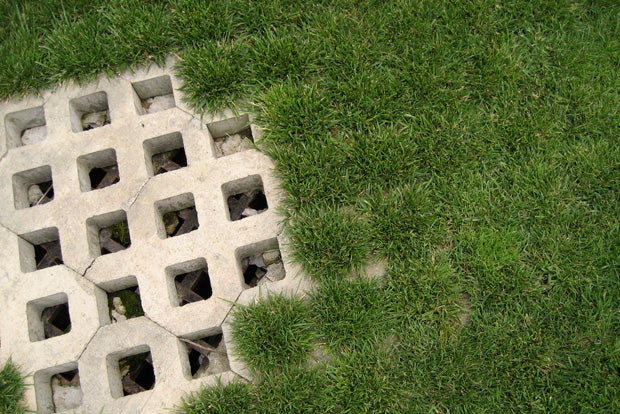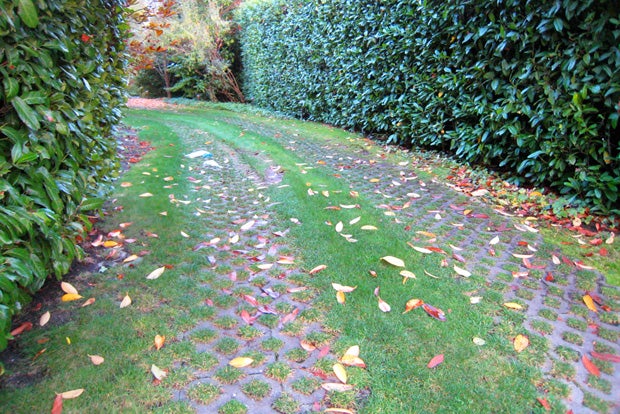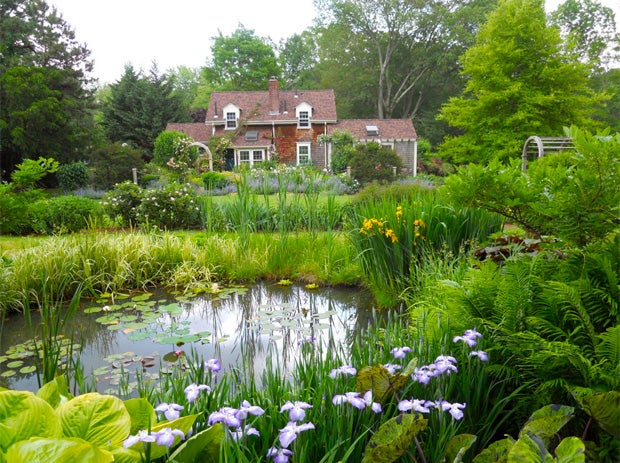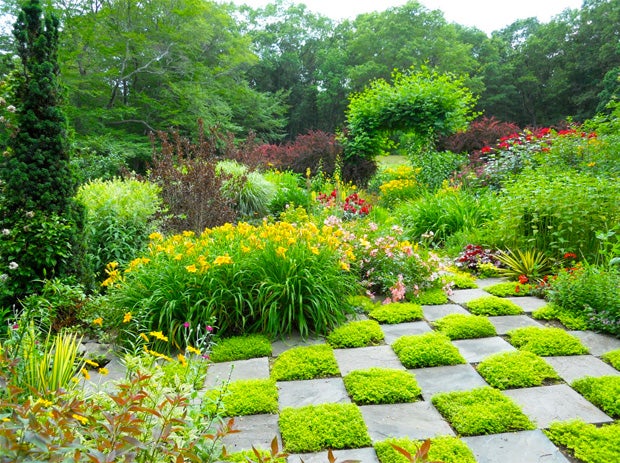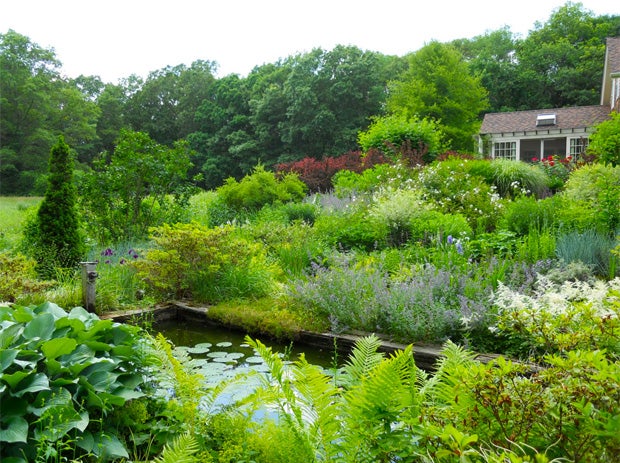Tired of bending? Garden on a table top!
ListenHighlights from show for April 20, 2013:
Embracing a permeable surface driveway
Ken from Spokane, Washington is tied up in a 200-foot long dilemma. He needs to find a way to easily kill off the weeds and grass that are growing in between the rocks on his long crushrock driveway. At the same time, he wants to stay away from using the chemicals in commercial products which could be hazardous to both himself and the lawn. The first thing Mike points out is, “Grass is our worst weed, Ken! … The definition of a weed is a great plant in the wrong place.” Mike commiserated with Ken, as he also has a crushrock driveway. In the past, Mike has used a handheld flame weeder or high strength vinegar herbicides to get rid of the weeds on his driveway, however, he came to a realization that fixing the problem was much easier than expected: “… I visited a Frank Lloyd Wright house in Wichita that had permeable blocks for their parking lot. These are sometimes called eco pavers; they’re specially-made driveway pavers that are full of holes so plants are designed to grow up through them so that when rainwater comes, the storm water’s managed as if it were landing on a lawn. But the pavers keep the surface stable for the parking of cars, and all that they do is mow it once a month down to around two inches. And I looked at this and I literally — in front of the tour guide — started slapping myself in the head, realizing I was wasting time, I was wasting gas, I was wasting vinegar.”
“In one season I had come up with a plan of infrequent mowing that allowed the driveway to fill in and look beautiful.”
Mike McGrath
Slideshow below: Eco paver designs
Growing asparagus
Anne from Ardmore, Pennsylvania is in her fifth year growing in her 22-foot asparagus bed. Over the winter, she covers the entire bed with straw to keep it warm until spring, and she wonders if she can later use that straw to make compost for her asparagus. Mike acknowledges that soil is often covered with mulch or straw, but leaving it on during the spring would stunt plant growth. Once the straw is removed, compost can be added to the top, and then the mulch can be put back on to prevent weeds. Mike suggests: “If you took that bale of straw, chopped it up finely, mixed it with five pounds of wet coffee grounds — which you can get from any coffee shop, any coffee shop would be happy to have and give you their grounds — that would turn into super premium compost. It would be the kind of nitrogen rich compost that your asparagus really likes.”
Special guest: Laura Palmer of The Garden Conservancy
Laura Palmer, deputy director of administration at The Garden Conservancy and director of the Open Days Program speaks with Mike about the upcoming Philadelphia Open Day on May 5th. The Garden Conservancy, founded in 1989, works to preserve gardens that would otherwise be bulldozed or destroyed to share those beautiful spaces with the public and to raise public awareness of the role that gardens play in America’s heritage. This year, to fund those projects, Open Days Program will feature 311 private gardens, open for public viewing in 18 states around the country. Laura explains, “We have a lot of garden hosts that have been open for us since 1995 — they’ve been at it as long as I have! It’s a tremendous endorsement of how enjoyable the program can be for garden hosts; we really like to hear about those experiences. It’s evident in the fact that people come back year after year to show their gardens, and people return and visit a garden often.” Individuals can visit each of these magnificent gardens for a nominal fee which goes directly to the cause of garden preservation.
Fifteen private gardens will be on display in the Philadelphia region on May 5th, 2013, the same year that The Garden Club of America, of whom Open Days is presented in collaboration with, is celebrating their 100th year anniversary. For anyone living or traveling out to the West Coast, Laura urges listeners to see the incredible Garden of Alcatraz in San Francisco. For listeners on the East Coast, there are Open Days from April through November. Laura especially recommends visiting the John P. Humes Japanese Stroll Garden in Mill Neck, NY. Gardens will be open to the public across the United States. Visit www.gardenconservancy.org to find the open day in your area.
The Garden Conservancy offers various publications, resources, and information for gardeners who care about the future of their garden and want to ensure that it is properly maintained and perhaps even on public display for decades to come. “A good way to start that process is to open for an open day. You get a sense of how people respond to a garden, what a terrific resource it can be for your community, and what a great joy it is to share creation that you’ve spent a lot of time and energy working on. I think that’s the real good part about gardening,” Laura says.
The table below lists the gardens participating in the Philadelphia Area Open Day on May 5, 2013. Gardens will be open from 11 a.m. – 4 p.m. For more information, maps, or to view complete Open Day Program listings, visit www.opendaysprogram.org or call toll free 1-888-842-2442.
| The Garden of Elizabeth and Ralph Schumacher | King of Prussia, PA |
| The Garden of Ellen and Clifford Pemberton | Bryn Mawr, PA |
| The Garden of Lynn and Michael Gibbons | Bryn Mawr, PA |
| The Garden of Pat and Jack Kolff | Villanova, PA |
| The Garden of David and Myrna Pope | Philadelphia, PA |
| The Garden of Nancy Newman and Jonathan Morley | Philadelphia, PA |
| Krisheim | Philadelphia, PA |
| The Stable Garden | Wyndmoor, PA |
| The Garden of Dr. and Mrs. Joel Wasley | Haverford, PA |
| The Garden of Reggie and Frank Thomas | Haverford, PA |
| The Garden of Jay and Nanie Flaherty | Philadelphia, PA |
| The Garden of Charles and Gene Dilks | Philadelphia, PA |
| The Garden of Alice and Richard Farley | Chestnut Hill, PA |
| The Garden of Lorraine and Peter Wallace | Gladwyne, PA |
| Guildford | Wyndmoor, PA |
Slideshow below: 2011 Garden Tour of Andrew Grossman, Seekonk, MA
Off to garden in Dallas!
After seven years of living in Nazareth, Pennsylvania, Andy will be moving to Dallas, Texas and wants to know what he can expect in terms of gardening in the Southwestern part of the country. While water conservancy is obviously a challenge for that part of America, “You will be able to grow everything that you can grow here, plus a couple of other things and you will be able to have plants outdoors over winter that either would’ve died in Pennsylvania or would’ve had to be brought inside. You will have a much wider range of plants,” Mike encourages. However, he does advise Andy to visit the local County Extension Office in Dallas to learn about monthly temperature ranges. The only other piece of advice Andy needs is that, “A gardener in Dallas wants a house where the garden area gets some afternoon shade.” Good luck Andy on your great adventure!
Troubled tulips
Amber from Muncie, Indiana bought some beautifully colored tulips from the store, however, after she kept them indoors for a while, she planted them outside where they turned yellowish after a frost. She wants to know if there’s a way she can still save them. Mike explains that she was right to clip the fading flowers, which Amber did, but that the plant still needs to be fed and watered so the leaves could absorb more nutrients. Once the leaves turn brown, about a month later, there would be a baby flower inside the stem for next year. At that point, Amber can bring the plant inside, put it in the basement until about Halloween, at which time she can feed it an organic liquid fertilizer to be quickly absorbed.
Using saw dust for mulch
Lin from Millville, Pennsylvania has large amounts of saw dust from her horse farm that she would like to know if she can use for making a mulch. According to Mike, sawdust is very similar to wood chips in that they are both resistant to composting. In fact, sawdust would absorb the nutrients from the plants! “It has nothing good for plants in it and it will steal their food on the way to becoming soil-which it will eventually- but in the meantime I would not use that saw dust. If anything, I would spread it maybe in an area where there’s noxious weeds so it would steal their food. Use it as a killing mulch. If you have some plants coming up that are dangerous to horses, dump a foot of this sawdust on top of it and just smother them,” Mike says.
-
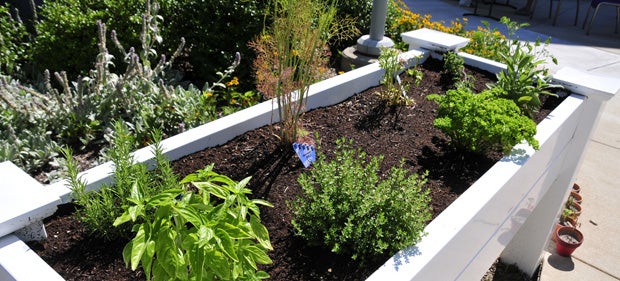
Photo by Flickr user Ranken Jordan
Question of the Week: Tired of bending? Garden on a table top!
I have a bad back and am looking for some kind of raised bed (to grow vegetables and herbs) that won’t require any bending. The space I have available is between 3′ x 3′ and 3′ x 5′; and I’d ideally like something with wheels so I could move it around for optimum light. What do you recommend?
Rosalie from Ardmore, Pennsylvania
Mike McGrath’s answer:
I don’t recommend that people with bad backs try and push heavy things around, so let’s ditch the wheels. But I know for a fact that you can grow a surprising amount of stuff in a three by three foot space, because that’s the size of an outdoor table I currently have covered with plants on our patio. It’s part of a set we bought years ago; a circular wrought iron table with four chairs and an umbrella for the middle. You’ll find similar pieces at every home store in the country.
Right now I have six rectangular containers on top of it. Each one is eighteen inches long and about six inches wide and high—the regular ‘window box’ style planters found at any garden center. I have some larger rectangular ones I could use instead but they’re really heavy when they’re full and so they stay on the ground. The 18 inch size is easy to lift, even when filled with plants and wet soil, and I like being able to move my containers without giving my aging back any bright ideas.
I ‘drilled’ extra drainage holes in the bottoms (I find that most window boxes don’t have enough drainage holes, so I heat up the tip of an ice pick or screwdriver for a few seconds and use it to make extra ones). Then I filled them with a mixture of soil-free mix and compost (as any good container should be filled; no rocks or pebbles in the bottom and no lousy garden soil).
They’re currently growing a lot of salad greens and pansies (which are pretty and edible), plus some spring bulbs I (successfully!) forced in a downstairs fridge. When the weather gets warmer, those cool-season plants will be replaced with herbs, peppers, little gourmet eggplants, bush string beans and summer flowers—like (also edible) nasturtiums, which should look great trailing over the side of the table. Arrange things well and you’ll have enough room in the middle for a “Patio size” tomato plant in a round pot. Or position a cherry tomato in one of the rectangular planters so the vines trail over the side of the table. At the end of summer, the containers will go back to lettuce, spinach and pansies for the fall; productive for a good nine months of the year (longer for those in climes warmer than mine).
You can sit in one of the chairs to play with your plants or stand next to the table to tend and pick—whatever you feel like that day.
I grow more and more in containers that are up on easy-to-reach platforms like this every season, as I have long ago lost any love of bending over. A few years from now, I may only have big plants like full-size tomatoes and raspberries in the actual ground.
I plant vegetable gardens professionally, and am installing a new raised bed that will be about 32″ tall for a client who needs to be able to reach the plants standing up instead of bending over. I usually fill new beds with half compost and soil free mix, but in one of your previous Questions of the Week, you recommend filling the bottom of a tall bed like this with rocks and then soil on top. Is putting rocks in the bottom better than filling it all up with compost? I usually try to have two feet of compost/soil free mix in my beds. I would love to get your recommendation. I enjoy listening to your show while I work in the garden! Thank you!
Autumn, near Walnut Creek; about 30 minutes east of San Francisco
Mike McGrath’s answer:
Years ago, I did suggest that someone building a super-tall ‘sky high’ bed put some kind of fill in the bottom, because the alternative seemed like a potentially expensive waste of good compost, and I was concerned about drainage issues. But I have since come to realize that there’s no need to build a tower, with or without rocks. Such a structure would, by its very nature, be ungainly and prone to failure, and you can accomplish the same height goal with less weight, work and inputs by gardening in containers on table tops.
As the years creep up on us, more and more gardeners are going to need a way to tend their plants while either sitting down or standing up; and while helping design a garden that would be wheelchair accessible a few years back, the idea came to me. Find sturdy tables of the correct height that fit the space, cover the tops of the tables with rectangular containers filled with compost and soil-free mix and you’ll be able to grow a huge diversity of plants without pain.
Think of picnic tables, or the wide variety of patio tables that are available in every shape and size. They’re designed for outdoor use and are just at the right height. You could even position a big 17-inch pot on the ground at each end of a table and grow a couple of full-sized tomato plants. No more bending, no more weeding, everything at arm’s height, easy to pick, easy to touch and smell.
Getting on in years? Got a concrete back yard? Renting or might have to move? Get some tables and containers and have the garden you want. Perhaps the garden of the future…
Find this Q&A helpful? Find more gardening solutions at Gardens Alive »
— This week’s post was written by Jolie Higazi, You Bet Your Garden Intern
WHYY is your source for fact-based, in-depth journalism and information. As a nonprofit organization, we rely on financial support from readers like you. Please give today.




